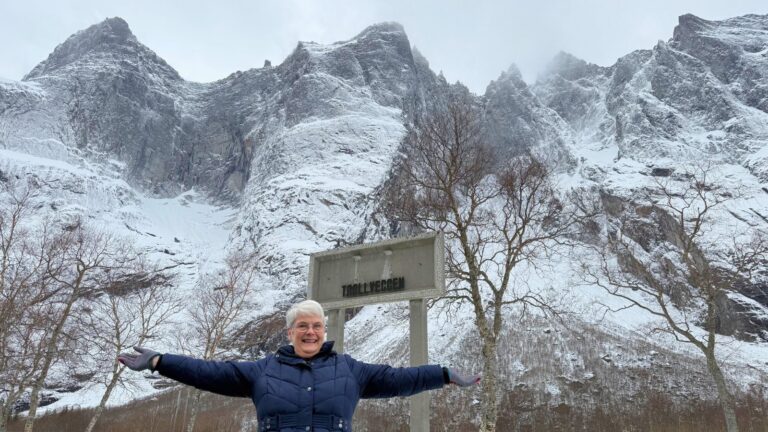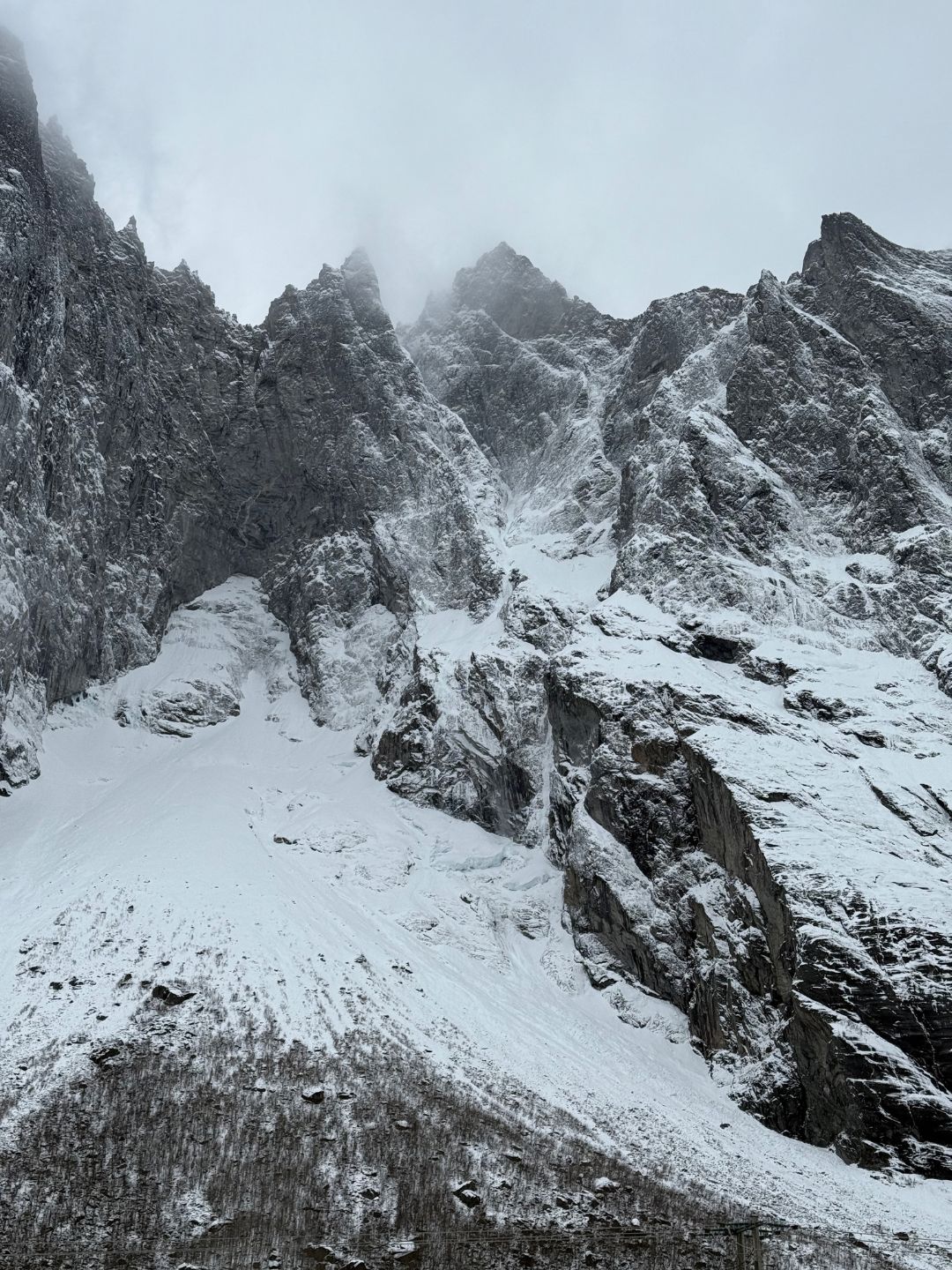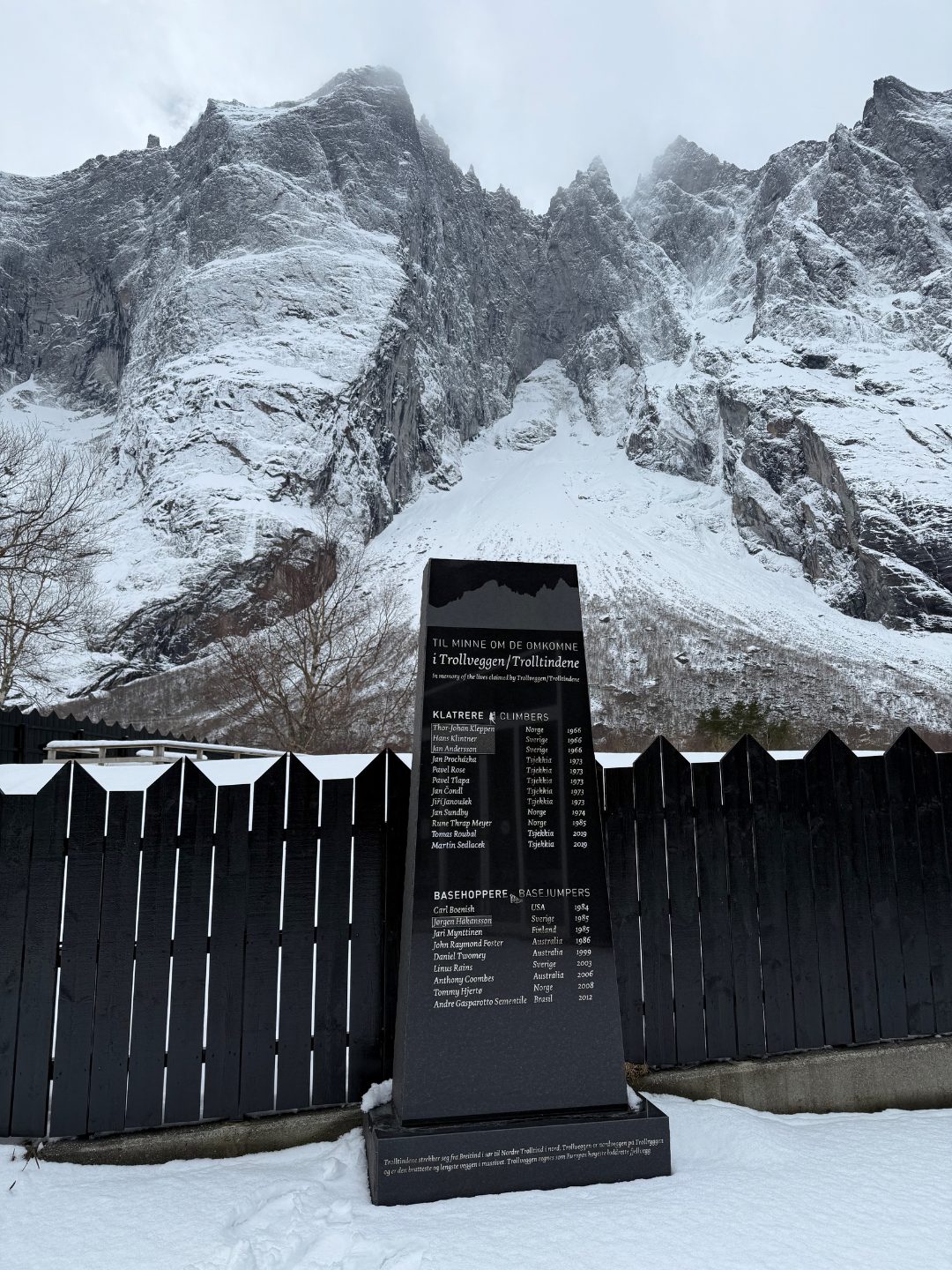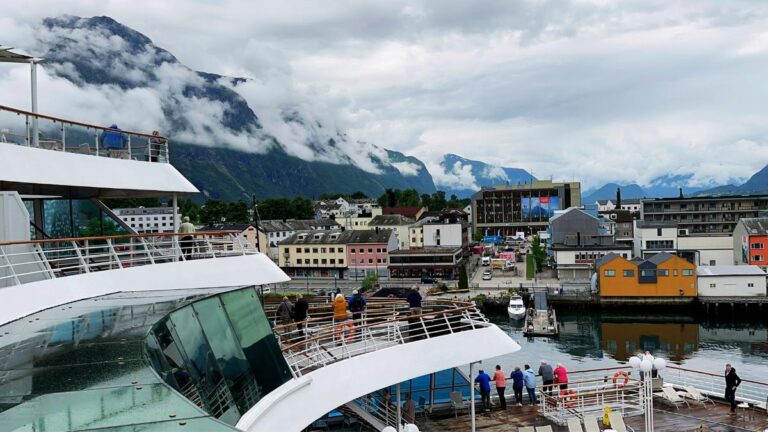Trollveggen, the crown jewel of Norway’s Romsdal Alps, is Europe’s tallest vertical rock face—a sheer wall of stone that stirs both awe and imagination. Towering above the valley floor, it’s a breathtaking sight in every season and a must-see for anyone drawn to Norway’s wild beauty.
We hadn’t even planned to see Trollveggen that day. It was March, and I was on a cruise with my mum when we docked in the little fjord town of Åndalsnes.

Snow still clung to the rooftops, and the jagged Romsdal Alps loomed dramatically in the distance, their peaks dusted with fresh powder under a pale winter sun.
Later in the day I had planned a trip up to the mountain on the Romsdal Gondola. To kill some time, I fancied an early morning wander around the town.
As I stepped ashore, I spotted a shuttle bus offering guided trips to Trollveggen—the famous ‘Troll Wall'. I’d been before, in summer, but the view had been fleeting: shrouded in mist, half-lost in cloud. This time was different.
Under a crisp blue sky, the wall stood proud, dusted with snow and shining in the cold light of winter. The sheer scale of it took my breath away.
In that moment, it was easy to see how Norway’s troll myths came to be—this jagged wall of stone looked exactly like trolls caught mid-step, frozen for eternity.
What Is Trollveggen?
Towering more than 1,000 metres (3,300 feet) above the Romsdalen valley, the wall appears to rise almost straight out of the ground, its craggy cliffs and jagged peaks forming a fortress-like barrier against the sky.

This formidable rock wall is part of the Trolltindane (Troll Peaks), a mountain range in the municipality of Rauma in Møre og Romsdal county.
Trolltindane includes several dramatic summits, including Store Trolltind, the highest peak at 1,788 metres. Together, these peaks form one of the most iconic—and intimidating—landscapes in Norway.
Trollveggen is notable not just for its sheer height, but for the way it drops nearly vertically from its highest point to the valley floor below. In some places, the upper part of the wall even overhangs, making it especially treacherous for climbers and creating an almost surreal silhouette when viewed from a distance.
Geologically, the wall is made up of ancient gneiss and granite, shaped by glaciers during the last Ice Age. Its rugged appearance has long stirred the human imagination, and not just among climbers: Trollveggen is deeply embedded in Norwegian folklore, tourism, and national identity.
Located just a few kilometres from Åndalsnes, the town that serves as the hub for exploring this region, Trollveggen is easily accessible by car or train.
Trollveggen: Beautiful But Deadly
Beneath the viewing area at Trollveggen, a memorial stone stands quietly next to a large orientation map of the wall. It’s a simple tribute, easy to overlook at first glance—but it carries a powerful message.
The names etched into the stone are those who have lost their lives attempting to conquer or fly from the Troll Wall. Many were climbers. Others were BASE jumpers.

The placement of the memorial, right beside the visitor map, is no accident. It’s a poignant reminder that this landscape, while stunning, demands respect. Trollveggen is more than a natural wonder—it’s also one of the most dangerous places in Norway for thrill-seekers.
Climbing here is treacherous even in summer. Loose rock, sudden weather changes, and the sheer verticality of the wall have contributed to numerous accidents over the decades.
In July 2019, two experienced Czech climbers fell to their deaths while attempting an ascent. Their loss shook Norway’s climbing community and served as a grim reminder of the wall’s unforgiving nature.
The dangers aren’t limited to climbers. In the 1980s and 1990s, Trollveggen became a mecca for BASE jumpers—those who leap from cliffs wearing parachutes or wingsuits.
While the wall’s overhanging cliffs made it an appealing challenge, the risk proved immense. At least eight people lost their lives in jumps from the Troll Wall, leading to a permanent ban on BASE jumping in 1986, a regulation still in place today.
Despite the risks, the wall continues to draw experienced climbers from around the world, drawn by its legendary status and the raw challenge it presents.
For most visitors, however, the best way to experience Trollveggen is from the ground—gazing up in awe, and reflecting on both the beauty and the brutal power of nature.
When To Visit Trollveggen
In spring and summer, the valleys burst into life with greenery and wildflowers, the days stretch long into the evening, and the roads are at their most accessible.

Many visitors are treated to clear views of the wall under bright blue skies—though, as with any mountainous region, the weather can change quickly, and occasional mist or cloud is still possible.
Autumn paints the landscape in vivid shades of gold and orange, and the trails are often quieter, ideal for those seeking a more reflective experience. The weather can be more unpredictable, but the drama of the season adds to the atmosphere.
In winter, the landscape transforms entirely. Snow blankets the peaks, the air is crisp and dry, and the light can be magical—especially on clear days when the wall is sharply defined against the sky. It may just be the most photogenic time to visit.
If you're travelling outside the summer season, it’s worth checking local road conditions and the opening times of the visitor centre, which may have reduced hours or be closed during the off-season.
Getting There
The small town of Åndalsnes serves as the gateway to Trollveggen and the Romsdal Alps.
Travelling by train offers one of the most scenic journeys in Norway: the Rauma Railway runs between Dombås and Åndalsnes, linking up with long-distance services from Oslo and Trondheim. The Rauma Railway runs right past Trollveggen.
Driving is another excellent option, especially for those planning to explore nearby attractions. From Oslo, the route follows the E6 north to Dombås, then continues along the E136 into the heart of the Romsdal valley. The drive is nothing short of spectacular.
Åndalsnes is also becoming an increasingly popular cruise destination. Many ships now call here and offer shore excursions to Trollveggen, Trollstigen, and beyond.
Beyond Trollveggen: Nearby Attractions
Just 20 kilometres from Trollveggen lies Trollstigen, one of Norway’s most famous mountain roads. Its eleven dramatic hairpin bends and towering cliffs make it a favourite among photographers and road trippers alike.

That said, the road has been prone to closures in recent years due to rockfalls, so it’s wise to check the latest travel advice before making the journey.
Back in Åndalsnes, the Romsdalen Gondola whisks you up to Nesaksla mountain for panoramic views over the valley and fjord. From the top, you can spot Trollveggen in the distance—and, if you’re feeling energetic, descend on foot via scenic trails.
For a more adventurous climb, the Rampestreken viewpoint is a must. This steel platform juts out from the cliffside high above the town and offers a heart-stopping view for those who conquer the steep but rewarding hike.
Finally, the Rauma River, which winds its way through the valley beneath Trollveggen, is perfect for trout fishing—or simply enjoying the peaceful sounds of nature.
My impromptu visit to Trollveggen reminded me of something simple yet powerful: in Norway, some of the best experiences aren’t the ones you plan. They’re the ones that find you—on a snowy March morning, with the light just right and the mountains silent, waiting.

